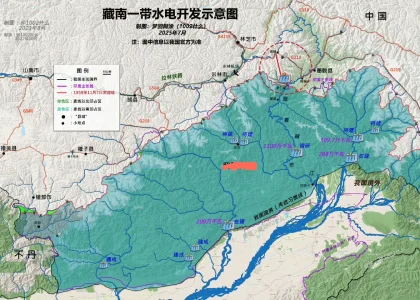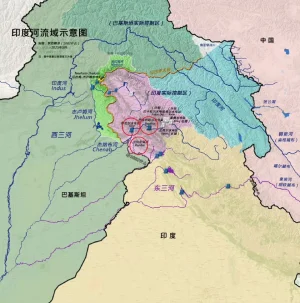- Joined
- Jul 2, 2024
- Messages
- 1,047
- Likes
- 4,292
CCP going to provide water to their new proxy Bangladesh during lean seasons via desalination plants?
CCP going to provide water to their new proxy Bangladesh during lean seasons via desalination plants?
China controls approx 30 percent of water only .
Data published by Chinese scholars and cited by Ghosh shows that Yarlung’s total annual outflow from China is about 31 Billion Cubic Metre (BMC). However, the annual flow of Brahmaputra at Bahadurabad gauging station in Bangladesh, close to the point where the river enters the country, is about 606 BCM.
At Nuxia and Tsela Dzong water measuring stations in Tibet, the peak flows during the monsoon season are about 5,000 and 10,000 cubic metre per second. But downstream in India, the peak flow increases, reaching around 40,000 cumes in Guwahati and 50,000 cumecs in Bangladesh’s Bahadurabad.
CCP going to provide water to their new proxy Bangladesh during lean seasons via desalination plants?
All Chapter of the PLA SF veteran's memoir during his tenure at LAC 2019-2021 are below
View: https://x.com/Duorope/status/1946834665320415360
View: https://x.com/Duorope/status/1946834667451146745
Tibet has no rain. The Brahmaputra water is glacier snow melt. It is not enough to build the big dam which Chinese plan. The dam will fail as gradient is too steep.China controls approx 30 percent of water only . Northeast get more water than they can use .. Too much rain there . Assam get flood every year . It's about watershed management with dams and canal that we need to worry about . Dams have to be accelerated on our side so that flooding can be prevented if water is released . It effects Bangladesh more .
All those tunnels in a seismic hazard/high risk zonesomething like this,
2000m drop in 40km
View attachment 44001
View attachment 44000
View attachment 44002View attachment 44003

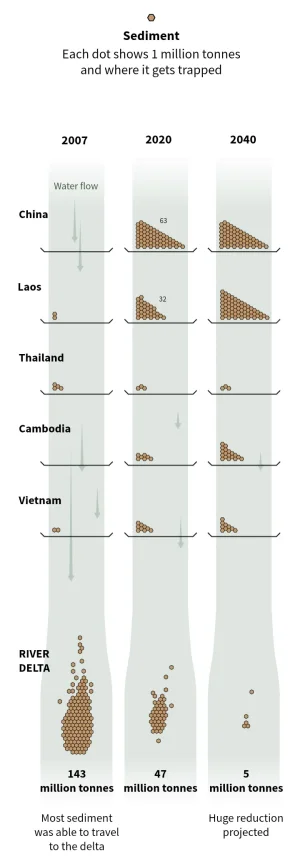

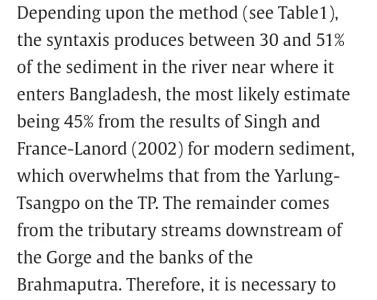
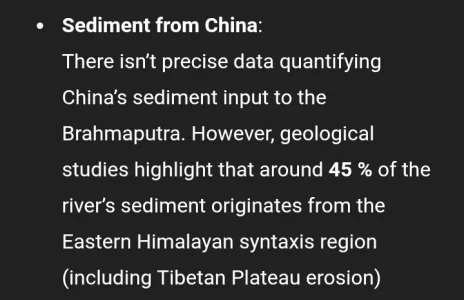
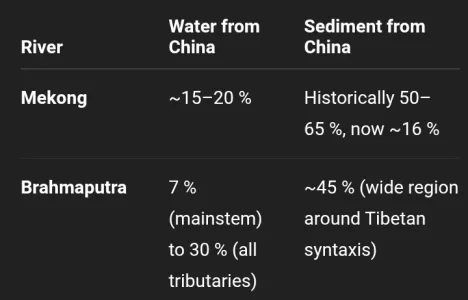
Shouldn't loss in sediment be of more concern to Bangladesh due to likely more sea ingress?I am not too worried about them trapping water. India isn't heavily dependent on Tibetan sources for its rivers. Even the Brahmaputra, which originates in Tibet, gets less than 30% of its water flow from there. I am more concerned about sedimentation loss due to the dams. This is already a problem faced by the Mekong River (in Southeast Asia) because of Chinese dams.
"The boom in water infrastructure in the Mekong Basin has raised concerns over the annual supply of water and sediment among its riparian communities. By consolidating various datasets, continuous series of sediment load data were estimated for several stations located within the Lower Mekong Basin. At Chiang Saen in Thailand, the nearest station to the Chinese dams, the average sediment load was 79 ± 32 Mt./yr during the pre-dam period of 1965–1991. However, from 2010 to 2019 – during which a series of mega-dams were built in China – the sediment load decreased drastically by 84 % to only 12.5 ± 4.6 Mt./yr. This phenomenon of reduced annual sediment load during the mega-dam era (2010–2019) as compared to during the pre-dam era (1965–1991) can be observed at stations downstream from Luang Prabang (−53 %) to Nong Khai (−62 %) to Khong Chiam (−33 %)."
--------Sediment load crisis in the Mekong River Basin: Severe reductions over the decades
View attachment 44009
If we compare the sediment in both rivers originating from Tibet and China, this is what I found using GPT and online sources. However, not much research has been conducted on the Brahmaputra River in this regard.
- For Mekong-
View attachment 44013
- For Brahmaputra-
View attachment 44012
View attachment 44011
Overall comparison-
View attachment 44010
Who cares about the kanglus? I am more concerned about our loses and gains. Anyways, I am not an expert on these, so any educated feedback on this concern would be appreciated.Shouldn't loss in sediment be of more concern to Bangladesh due to likely more sea ingress?
With both PRC and potential Indian dams coming up in next 10 years, what they might be looking at is minimal/less water in Brahmaputra during lean seasons and huge floods during monsoon. Due to reduced flow and sedimentation outside of monsoons, there will be sea ingress (it is happening in Sindh too but looks like this one will be worst).Who cares about the kanglus? I am more concerned about our loses and gains. Anyways, I am not an expert on these, so any educated feedback on this concern would be appreciated.
Edit: Around 70% of the kanglu land area is flood prone anyways. They are already living in hell level difficulty. What impact would it have on them?
Nearly 70% of Bangladesh is affected by flooding each year
Who cares about the kanglus? I am more concerned about our loses and gains. Anyways, I am not an expert on these, so any educated feedback on this concern would be appreciated.
Edit: Around 70% of the kanglu land area is flood prone anyways. They are already living in hell level difficulty. What impact would it have on them?
Nearly 70% of Bangladesh is affected by flooding each year
We're looking at massive influx of illegal lungis into India once the dam becomes operational. Not that they aren't hopping over even otherwise but the political instability there resulting in economic destabilization coupled with the various dams being built in Tibet , AP & Assam over the Brahmaputra is going to cause massive problems in Lungidesh.With both PRC and potential Indian dams coming up in next 10 years, what they might be looking at is minimal/less water in Brahmaputra during lean seasons and huge floods during monsoon. Due to reduced flow and sedimentation outside of monsoons, there will be sea ingress (it is happening in Sindh too but looks like this one will be worst).
